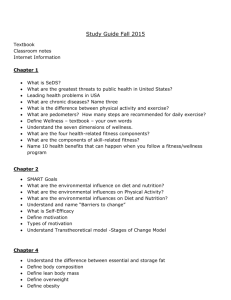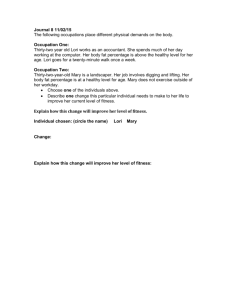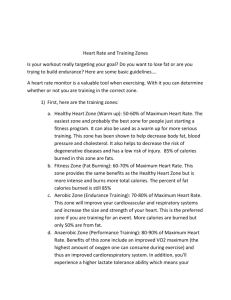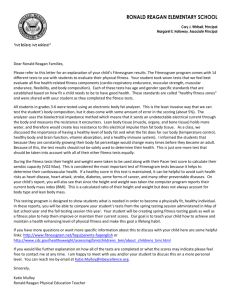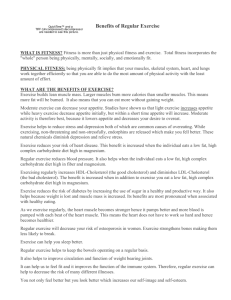Active Health Lesson 2 – Heart and FITT (PowerPoint)
advertisement
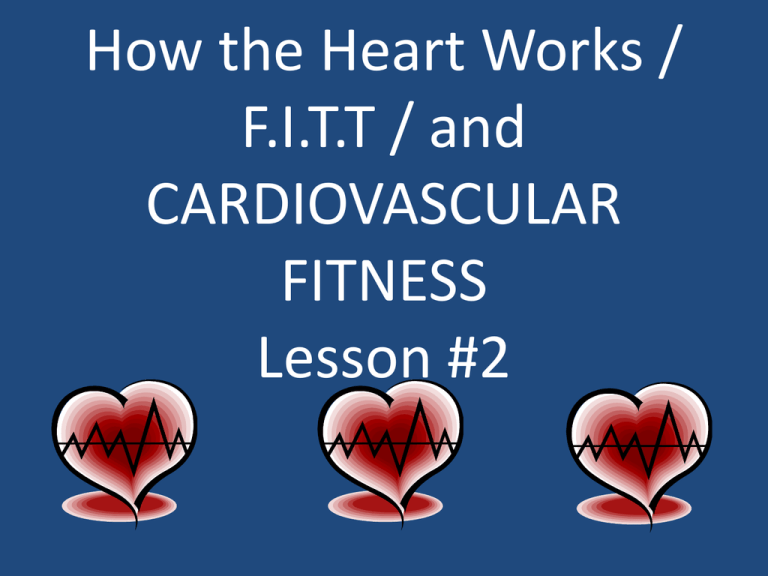
How the Heart Works / F.I.T.T / and CARDIOVASCULAR FITNESS Lesson #2 How the Heart Works Factors Affecting Heart Rate • GENDER: adult females average 5 – 10 beats per minute more than men due to supporting more body fat • SIZE: Extra body fat causes the heart to work harder • TEMPERATURE: A rise in body temperature will raise the heart rate eg. Hot tub, desert • DIGESTION: It takes extra energy to digest a meal • POSTURE: The more prone, the lower the heart rate. Heart Terminology • Cardio - the heart – about the size of a fist • The Heart – a hollow organ containing 4 chambers • Septum – wall which divides the heart cavity into a “right heart” & a “left heart” • Right Atrium/Left Atrium – holding tanks for the blood • Right Ventricle/Left Ventricle – acts as a pump • Vascular – systems of blood vessels • Veins – bring blood back to the heart • Arteries – take blood from the heart to the needy muscles & organs WHAT IS FITNESS? • PHYSICAL FITNESS DEFINITON: • Ability of the whole body (muscles, skeleton, heart & other body parts) to do work together efficiently • Ability to do the most work with the least amount of effort 2 CATEGORIES • HEALTH RELATED FITNESS • SKILL RELATED FITNESS CARDIOVASCULAR TRAINING F.I.T.T. FORMULA • FREQUENCY • INTENSITY • TIME/DURATION • TYPE FREQUENCY How often to exercise • Minimum – 3 X’s weekly • Maximum – 4-5 X’s weekly INTENSITY How hard to exercise • Minimum – heart rate above the lower limit of your training range • Maximum – heart rate below the upper limit of training range TYPE The kind of exercise you choose to participate in • Minimum – low impact exercise – walking • Maximum – high impact exercise - running TIME OR DURATION How long to exercise • Minimum – 15 minutes • Maximum – 30 minutes TARGET HEART RATE • Your target heart rate is the threshold of training you must work out at for the heart to receive any benefits • Exercise within your target heart rate for 1530 minutes to get maximum benefits of exercise Calculating your Maximum Heart Rate • Target heart rate range = 70-85% of maximum heart rate • Maximum heart rate = 220 – age – Fastest your heart can beat without collapse HOW TO FIND THE LOWER END OF YOUR TARGET HEART RATE RANGE • 220 – AGE • MULTIPY BY .70 • IF YOU SMOKE, ARE OVERWEIGHT OR RECOVERING FROM A SERIOUS ILLNESS – MULTIPLY BY .65 • 220-14 = 206 x .70 = 144 (fit individual) • 220-14 = 206 x .65 = 131 (unfit or unhealthy individual) THIS IS THE LOWEST YOUR HEART RATE SHOULD BE TO EXPERIENCE THE BENEFITS OF YOUR EXERCISE HOW TO FIND THE UPPER LIMIT OF YOUR TARGET HEART RATE RANGE • 220 – AGE • MULTIPY BY .85 • 220-14 = 206 x .85 = 175 THIS IS THE UPPER LIMIT YOUR HEART RATE SHOULD BE TO GET THE MOST BENEFITS FROM YOUR EXERCISE Other Important Terms • Recovery Heart Rate – time for heart to return to normal • Resting Heart Rate – heart rate when the body is resting Factors Affecting Heart Rate • GENDER: adult females average 5 – 10 beats per minute more than men due to supporting more body fat • SIZE: Extra body fat causes the heart to work harder • TEMPERATURE: A rise in body temperature will raise the heart rate eg. Hot tub, desert • DIGESTION: It takes extra energy to digest a meal • POSTURE: The more prone, the lower the heart rate.


